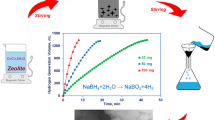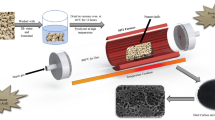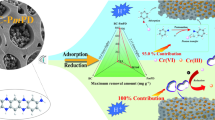Abstract
For the first time, hydroxypropyl-β-cyclodextrin (HP-β-CD) has been brought in to include 2-phosphonobutane-1,2,4-tricarboxylic acid (PBTCA) in order to enhance inhibition efficiency of PBTCA, which leads a new approach to study oil–gas field corrosion inhibition in the process of acid treatment. Based on the host–guest inclusion reaction, the inclusion complex of PBTCA with HP-β-CD has been prepared in the laboratory. UV–Vis absorption spectrum was applied to study the inclusion behavior of PBTCA with HP-β-CD. The results revealed that PBTCA with HP-β-CD can form a 1:1 stoichiometry inclusion complex. The 1:1 inclusion complex synthesized by using lyophilization was further characterized by Fourier transform infrared spectroscopy. Besides, inhibition effect of the inclusion complex on the corrosion inhibition of Q235 carbon steel has been investigated in 0.1 M sulfuric acid (H2SO4) solution using potentiodynamic polarization, electrochemical impedance spectroscopy techniques and scanning electron microscopy (SEM). It was found that the presence of the inclusion complex better achieved the anti-corrosion property in aggressive medium than was the case with alone PBTCA and the highest inhibition efficiency of the inclusion complex over 90 % was obtained, which are suggestive of the active effect of the inclusion complex for improving inhibition efficiency of PBTCA. Meanwhile, the results obtained from SEM further showed that the inclusion complex acts as a more efficient corrosion inhibitor for Q235 carbon steel in H2SO4 medium.














Similar content being viewed by others
References
Zhang, G.C., Ge, J.J., Sun, M.Q., Pan, B.L., Mao, T., Song, Z.Z.: Investigation of scale inhibition mechanisms based on the effect of scale inhibitor on calcium carbonate crystal forms. Sci. China, Ser. B: Chem. 55(1), 114–120 (2007)
Zhang, W., Lu, X., Liu, Y., Pan, G., Luo, J.: Chemical mechanical polishing of copper in organic phosphonic acid system slurry. Technical Sessions—Proceedings of CIST2008 & ITS-IFToMM2008 Beijing, China, 906-907 (2008)
Abulkibash, A., Khaled, M., Elali, B.: Corrosion inhibition of steel in cooling water system by 2-phosphonobutane-1,2,4-tricarboxylic acid and polyvinylpyrrolidone. Arab. J. Sci. Eng. 33(1A), 29–40 (2008)
Benabdellah, M., Ousslim, A., Hammouti, B., Elidrissi, A., Aouniti, A., Dafali, K., Bekkouch, K., Benkaddour, M.: The effect of poly(vinyl caprolactone-co-vinyl pyridine) and poly(vinyl imidazol-co-vinyl pyridine) on the corrosion of steel in H3PO4 media. J. Appl. Electrochem. 37, 819–826 (2007)
Al-Sarawy, A.A., Fouda, A.S., Shehab El-Dein, W.A.: Some thiazole derivatives as corrosion inhibitors for carbon steel in acidic medium. Desalination 229, 279–293 (2008)
Hosseini, M.G., Tavakoli, H., Shahrabi, T.: Synergism in copper corrosion inhibition by sodium dodecylbenzenesulphonate and 2-mercaptobenzoimidazole. J. Appl. Electrochem. 38, 1629–1636 (2008)
Umoren, S.A., Obot, N.I.B., Obi-Egbedi, O.: Raphia hookeri gum as a potential eco-friendly inhibitor for mild steel in sulfuric acid. J. Mater. Sci. 44, 274–279 (2009)
Hosseini, M.G., Khalilpur, H., Ershad, S., Saghatforoush, L.: Protection of mild steel corrosion with new thia-derivative Salens in 0.5 M H2SO4 solution. J. Appl. Electrochem. 40, 215–223 (2010)
Fu, J.-J., Li, S.-N., Cao, L.-H., Wang, Y., Yan, L.-H., Lu, L.-D.: l-Tryptophan as green corrosion inhibitor for low carbon steel in hydrochloric acid solution. J. Mater. Sci. 45, 979–986 (2010)
Gopi, D., Govindaraju, K.M., Kavitha, L.: Investigation of triazole derived Schiff bases as corrosion inhibitors for mild steel in hydrochloric acid medium. J. Appl. Electrochem. 40, 1349–1356 (2010)
Shah, P.P., Shukla, S.K., Misra, A.N., Patel, D.C.: Scale inhibition in recirculating cooling water system by low concentration of organic inhibitors. Chem. Eng. World 28, 83–86 (1993)
Rajendran, S., Apparao, B.V., Palaniswamy, N.: Synergistic effect of Zn2+ and ATMP in corrosion inhibition of mild steel in neutral environment. Bull. Electrochem. 12, 15–19 (1996)
Rajendran, S., Apparao, B.V., Periasamy, V., Karthikeyan, G., Palaniswamy, N.: Comparison of the corrosion inhibition efficiencies of the ATMP-molybdate system and the ATMP-molybdate-Zn2+ system. Anti-Corros. Method. Mater. 45, 109–112 (1998)
Rajendran, S., Earnest John, P.B.R.E., Peter Pascal, R.A., John, A.A., Sundaravadevelu, A.M.: Influence of chloride ion concentration on the inhibition efficiency of the HEDP-Zn2+ system. Trans. SAEST 38, 11–15 (2003)
Yabuki, A., Kunimoto, H.: Optimum condition of phosphonic acid inhibitor under a flowing solution. Zairyo to Kankyo/Corrosion Engineering. 54, 74–78 (2005)
Thi Xuan Hang, T., Truc, T.A., Nam, T.H., Oanh, V.K., Jorcin, J.B., Pébère, N.: Corrosion protection of carbon steel by an epoxy resin containing organically modified clay. Surf. Coat. Technol. 201, 7408–7415 (2007)
Mohanan, S., Maruthamuthu, S., Kalaiselvi, N., Palaniappan, R., Venkatachari, G., Palaniswamy, N., Raghavan, M.: Role of quaternary ammonium compounds and ATMP on biocidal effect and corrosion inhibition of mild steel and copper. Corros. Rev. 23, 425–444 (2005)
Thammarat, A., Burkhard, S., Gunter, R.: Crystal structures of β-cyclodextrin complexes with formic acid and acetic acid. J. Incl. Phenom. Macrocycl. Chem. 47, 39–45 (2003)
Irina, V.T., Natalya, A.O.: Study on inclusion complex formation of m-aminobenzoic acid with native and substituted β-cyclodextrins. J. Solution Chem. 36, 1167–1176 (2007)
Shen, Q., Wu, X.H., Wang, M., Shen, X.Q., Ren, Y., Wu, G.R.: Study on identification and anti-lipid peroxidation effects of β-cyclodextrin inclusion of chlorogenic acid extracted from dandelion. Food Sci. 28, 30–34 (2007)
Belyakova, L.A., Varvarin, A.M., Lyashenko, D.Y., Khora, O.V., Oranskaya, E.I.: Complexation in a β-cyclodextrin-salicylic acid system. J. Colloid. 69, 546–551 (2007)
Cappello, B., Maio, C., Iervolino, M., Miro, A.: Combined effect of hydroxypropyl methylcellulose and hydroxypropyl-β-cyclodextrin on physicochemical and dissolution properties of celecoxib. J. Incl. Phenom. Macrocycl. Chem. 57, 237–244 (2007)
Patel, R., Bhimani, D., Patel, J., Patel, D.: Solid-state characterization and dissolution properties of ezetimibe–cyclodextrins inclusion complexes. J. Incl. Phenom. Macrocycl. Chem. 60, 241–251 (2008)
Horiuchia, Y., Abea, K., Hirayamaa, F., Uekama, K.: Release control of theophylline by β-cyclodextrin derivatives: hybridizing effect of hydrophilic, hydrophobic and ionizable β-cyclodextrin complexes. J. Controlled Release 15, 177–183 (1991)
Hostetlera, J.S., Hansonc, L.H., Stevensa, D.A.: Effect of hydroxypropyl-β-cyclodextrin on efficacy of oral itraconazole in disseminated murine cryptococcosis. J. Antimicrob. Chemother. 32, 459–463 (1993)
Cserháti, T., Forgács, E.: Inclusion complex formation of steroidal drugs with hydroxypropyl-β-cyclodextrin studied by charge-transfer chromatography. J. Pharm. Biomed. Anal. 18, 179–185 (1998)
Zou, C.J., Liao, W.J., Zhang, L., Chen, H.M.: Study on acidizing effect of β-cyclodextrin-PBTCA inclusion compound with sandstone. J. Petrol. Sci. Eng. 77, 219–225 (2011)
Ventura, C.A., Giannone, I., Paolino, D., Pistara`, V., Corsaro, A., Puglisi, G.: Preparation of celecoxib-dimethyl-β cyclodextrin inclusion complex: characterization and in vitro permeation study. Eur. J. Med. Chem. 40, 624–631 (2005)
Tong, L.H.: Cyclodextrin Chemistry-Foundation and Application. Beijing Science Press, China (2001)
Kalman, E.: Corrosion Inhibitors. Published for EFC No. 11, Institute of Materials, London. (1999)
Gopi, D., Rajeswari, S.: In Proceedings of NACE international conference, corrosion its mitigation and preventive maintenance, Mumbai, India. 435 (2000)
Gopi, D., Rajeswari, S.: In Proceedings of tenth national congress on corrosion control conference, Madurai, India. 353 (2000)
Acknowledgments
This work has been supported by the National High Technology Research and Development Program (“863” Program) of China (2007AA11A117) from the Ministry of Science and Technology of China. Financial support of the “863” Program is highly appreciated.
Author information
Authors and Affiliations
Corresponding author
Rights and permissions
About this article
Cite this article
Zou, C.J., Tang, Q.W., Lan, G.H. et al. Enhancement inhibition efficiency of PBTCA depending on the inclusion complex with hydroxypropyl-β-cyclodextrin. J Incl Phenom Macrocycl Chem 76, 61–68 (2013). https://doi.org/10.1007/s10847-012-0173-1
Received:
Accepted:
Published:
Issue Date:
DOI: https://doi.org/10.1007/s10847-012-0173-1




